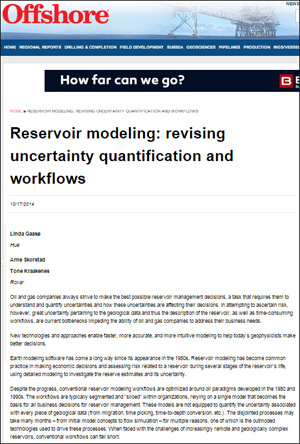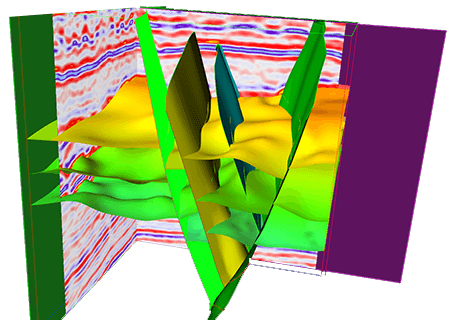PetroWiki defines reservoir management as:
…a dynamic process that recognizes the uncertainties in reservoir performance resulting from our inability to fully characterize reservoirs and flow processes. It seeks to mitigate the effects of these uncertainties by optimizing reservoir performance through a systematic application of integrated, multidisciplinary technologies. It approaches reservoir operation and control as a system, rather than as a set of disconnected functions.

Tone Kråkenes
Software Product Manager

Arne Skorstad
Technical Product Manager
 The article opens noting the challenges in understanding and quantifying uncertainties in managing oil & gas reservoirs:
The article opens noting the challenges in understanding and quantifying uncertainties in managing oil & gas reservoirs:
In attempting to ascertain risk, however, great uncertainty pertaining to the geological data and thus the description of the reservoir, as well as time-consuming workflows, are current bottlenecks impeding the ability of oil and gas companies to address their business needs.
Much of the conventional approach to reservoir modeling workflows were developed in the 1980s and 1990s and are:
…typically segmented and “siloed” within organizations, relying on a single model that becomes the basis for all business decisions for reservoir management. These models are not equipped to quantify the uncertainty associated with every piece of geological data (from migration, time picking, time-to-depth conversion, etc.). The disjointed processes may take many months – from initial model concepts to flow simulation – for multiple reasons, one of which is the outmoded technologies used to drive these processes.
To overcome the limitations in these traditional serial workflows, Emerson’s team managing the Roxar Reservoir Management Software and services developed a model-driven interpretation approach. This workflow:
…allows geoscientists to guide and update a structural 3D model, which is geologically consistent, directly from the data. This approach allows geoscientists to focus efforts where the model needs more details. In some areas, such as on a horizon depth, neighboring data tell the same story; they are all representative. In other areas, for example close to faults, some data points are more important than others, namely those indicating where the faults create a discontinuity horizon depth. Geoscientists should focus on these critical data points, instead of on data not altering the model.
 The Roxar RMS 2013 reservoir management software allows users to capture uncertainty throughout the interpretation process, generate multiple realizations, and build accurate and robust reservoir models that enable oil and gas producers to improve reservoir management decisions.
The Roxar RMS 2013 reservoir management software allows users to capture uncertainty throughout the interpretation process, generate multiple realizations, and build accurate and robust reservoir models that enable oil and gas producers to improve reservoir management decisions.
Modelers create thousands of models by estimating uncertainty in their interpretations and the RMS 2013 software can then generate statistically significant ensembles of models based on these probability distributions.
These models can be used to investigate key risks in the prospect, or areas can be quickly identified for more study. Efforts can then be focused where the model needs details, especially in those challenging, complex geometries common in many reservoirs today.
Model driven interpretation helps foster collaboration among geophysicists, with their understanding of the complexities of seismic data and geologists, with their understanding of the lithologies and facies.
The authors conclude the article:
The pressure is on oil and gas companies to make smart and economic decisions to maximize reservoir recovery. Current commercially available tools and workflows do not adequately address the need for making the best economic decisions and for assessing risk related to a reservoir. Limitations result in rigid models that are not flexible when it comes to incorporating new data, even though updated models leads to new knowledge and a better understanding of the reservoir.
Technology to support a better reservoir understanding is available. Operators can continuously update models everywhere in the workflow, from seismic to simulation. A combination of powerful hardware, an intelligent visualization-driven framework for computation and data-management, and a model-driven software approach to interpreting and modeling workflows can properly support reservoir modeling demands.
You can connect and interact with other oil & gas exploration and production experts in the Oil and Gas group in the Emerson Exchange 365 community.




